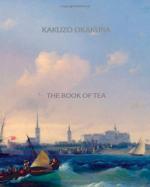|
This section contains 233 words (approx. 1 page at 400 words per page) |

|
Tea-Masters Summary and Analysis
Tea-masters were conscious of art as a living, present influence. They also believed that art begins from within, that even the tea-master was art himself. As such, etiquette, bearing, posture, clothing, walking gait, and many other things were all consciously controlled, especially during the tea ceremony.
Tea masters have done much to further art in Japan, from architecture to garden design and pottery. However, tea master influence also is reflected in aspects of everyday life. Many dishes are the invention of tea masters. Their sober dress have influenced many Japanese. They created the art of flower arrangement.
Lastly, tea masters have an understanding of the brevity of life, and how temporary it is, that life is a "tumultuous sea of foolish troubles." As such, death is no great thing to these masters. To illustrate this, Okakura tells the story of the...
(read more from the Tea-Masters Summary)
|
This section contains 233 words (approx. 1 page at 400 words per page) |

|




